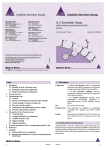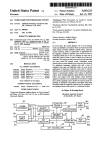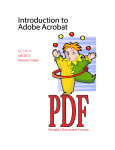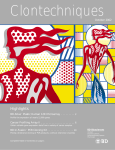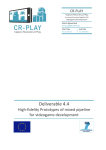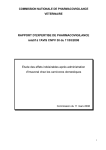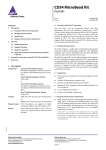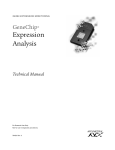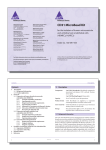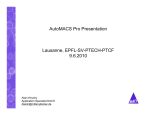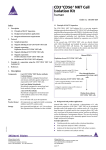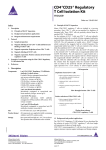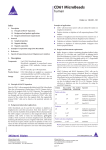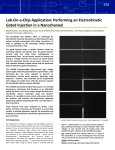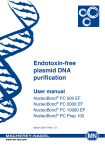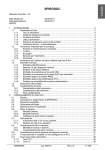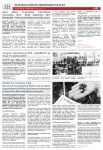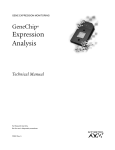Download IFN-γ Secretion Assay IFN-γ Secretion Assay
Transcript
Cytokine Secretion Assays Cytokine Secretion Assays Cytokine Secretion Assay Miltenyi Biotec S.r.l. (Italy) Miltenyi Biotec GmbH Friedrich-Ebert-Str. 68 51429 Bergisch Gladbach, Germany Phone: +49 2204 83060 Fax: +49 2204 85197 [email protected] Miltenyi Biotec Inc. 2303 Lindbergh Street, Auburn CA 95602, USA Phone: 800 FOR MACS, +1 530 888 8871 Fax: +1 530 888 8925 [email protected] Miltenyi Biotec Pty. Ltd. (Australia) Phone: +61 2 8877 7400 Fax: +61 2 9889 5044 [email protected] Miltenyi Biotec Shanghai Office Phone: +86 21 62351005 Fax: +86 21 62350953 [email protected] Miltenyi Biotec (France) Phone: +33 1 56 98 16 16 Fax: +33 1 56 98 16 17 [email protected] IFN-γ Secretion Assay Cell Enrichment and Detection Kit (PE) IFN-γ human Secretion Assay Phone: +39 51 64 60 411 Fax: + 39 51 64 60 499 [email protected] Miltenyi Biotec K.K. (Japan) Phone: +81 3 56 46 8910 Fax: +81 3 56 46 89 11 [email protected] Cell Enrichment and Detection Kit (PE*) human 7 Miltenyi Biotec Asia Pacific Pte. Ltd. (Singapore) Phone: +65 6238 8183 Fax: +65 6238 0302 [email protected] For 50 tests with 10 cells Order No. 130-054-201 For 50 tests with 107 cells Order No. 130-054-101 Miltenyi Biotec S.L. (Spain) Phone: +34 91 512 12 90 Fax: +34 91 512 12 91 [email protected] Miltenyi Biotec Ltd. (UK) Phone: +44 1483 799 800 Fax: +44 1483 799 811 [email protected] For further information refer to our website www.miltenyibiotec.com 140-000-274.07 For technical questions, please contact your local distributor or our Technical Support Team in Germany: e-mail: [email protected] phone: +49-2204-830 6 830. This MACS® product is for in vitro research use only and not for diagnostic or therapeutic procedures. 1. Description Index Index 1. 2. 3. 4. 5. 6. 7. 2 1. Description Description 1.1 Principle of the IFN-γ Secretion Assay 1.2 Background and product applications 1.3 Reagent and instrument requirements Protocol overview Experimental set-up 3.1 Controls 3.2 Kinetics of restimulation and proposed time schedule 3.3 Counterstaining of cytokine secreting cells 3.4 Two color cytokine analysis 3.5 Combination with peptide-MHC tetramer staining 3.6 Detection without prior enrichment Protocol for the IFN-γ Secretion Assay 4.1 Cell preparation 4.2 (Antigen-specific) In vitro stimulation 4.3 Cytokine Secretion Assay 4.4 Magnetic labeling 4.5 Magnetic separation Detection and analysis of IFN-γ secreting antigen-specific T cells References Appendix A: Flask and dish sizes for stimulation B: Detection and enrichment of cytokine secreting cells from whole blood 140-000-274.07 Components 1 mL IFN-γ Catch Reagent: anti-IFN-γ monoclonal antibody (mouse IgG1) conjugated to cell surface specific monoclonal antibody (mouse IgG2a). 1 mL IFN-γ Detection Antibody: anti-IFN-γ monoclonal antibody (mouse IgG1) conjugated to PE (R-phycoerythrin). 1 mL Anti-PE MicroBeads: colloidal superparamagnetic MicroBeads conjugated to monoclonal mouse anti-PE antibody (mouse IgG1). Size For 50 tests with 107 cells Product format All components are supplied as a suspension containing stabilizer and 0.05% sodium azide. Storage Store protected from light at 4–8 °C. Do not freeze. The expiration dates are indicated on the vial labels. 140-000-274.07 3 1. Description 1. Description labeled with a second IFN-γ-specific antibody, the IFN-γ Detection Antibody conjugated to R-phycoerythrin (PE) for sensitive detection by flow cytometry. Anti-PE MicroBeads IFN-γ Catch Reagent IFN-γ Detection Antibody (PE) The IFN-γ-secreting cells can now be magnetically labeled with AntiPE MicroBeads and enriched over a MACS® Column which is placed in the magnetic field of a MACS Separator. The magnetically labeled cells are retained in the MACS Column while the unlabeled cells run through. After the column has been removed from the magnetic field, the magnetically retained cells can be eluted as positively selected cell fraction, enriched for cytokine secreting cells. The cells can now be used for cell culture or analysis. Since viable cells are analyzed, non-specific background can be minimized by dead cell exclusion. This provides highest sensitivity of analysis. IFN-γ secreting cell 1.2 Background and product applications 1.1 Principle of the IFN-γ Secretion Assay Antigen-specific T cells are analyzed and isolated using the IFN-γ Secretion Assay starting from whole blood, PBMC or other leukocyte containing single-cell preparations. The cells are restimulated for a short period of time with specific peptide, protein or other antigen preparations. The IFN-γ Secretion Assay - Cell Enrichment and Detection Kit is designed for the detection, isolation and analysis of viable IFN-γ secreting leukocytes. It is specially developed for the detection and isolation of antigen-specific T cells. After restimulation with specific antigen in vitro secretion of IFN-γ is induced. IFN-γ is predominantly secreted by activated CD4+ and CD8+ memory and effector T cells and by NK cells upon activation. Subsequently, an IFN-γ-specific Catch Reagent is attached to the cell surface of all leukocytes. The cells are then incubated for a short time at 37 °C to allow cytokine secretion. The secreted IFN-γ binds to the IFN-γ Catch Reagent on the positive, secreting cells. These cells are subsequently Quantitative analysis of antigen-specific T cell populations can provide important information on the natural course of immune responses. MACS enrichment of the antigen-specific T cells increases the sensitivity of analysis, allowing detection of frequencies as low as one in a million cells. 4 140-000-274.07 140-000-274.07 5 1. Description 1. Description The MACS enrichment also enables further functional characteri-zation of the antigen-specific cells and downstream experiments, as well as the expansion of antigen-specific cells allowing research on potential future immunotherapeutical applications. 1.3 Reagent and instrument requirements ● Buffer (degassed): Prepare a solution containing PBS (phosphate buffered saline) pH 7.2, 0.5% BSA and 2 mM EDTA by diluting MACS BSA Stock Solution (# 130-091-376) 1:20 with autoMACS™ Rinsing Solution (# 130-091-222). Keep buffer cold (4−8 °C). Examples of applications ● Detection and enrichment of viable IFN-γ-secreting leukocytes. ● ● Detection and enrichment of IFN-γ-secreting, antigen-specific T cells for enumeration and phenotypic analysis as well as for expansion and functional characterization. Culture medium, e.g. RPMI 1640 (# 130-091-440), containing 5% human serum, like autologous or AB serum (do not use BSA or FCS because of non-specific stimulation!). ● Propidium iodide (PI) or 7-AAD for flow cytometric exclusion of dead cells. For cell fixation and flow cytometric exclusion of dead cells, the Fixation and Dead Cell Discrimination Kit (# 130-091-163) is recommended. ● (Optional) Staining reagents such as CD4-FITC (# 130-080-501) or CD8-FITC (# 130-080-601) and CD14-PerCPTM. ● Monitoring and analysis of antigen-specific T cell immunity, e.g. in infection, autoimmunity, cancer, allergy or alloreactivity. ● Isolation and expansion of antigen-specific T cells for research in immunotherapy. ● Enrichment and analysis of IFN-γ secreting cells for determination of functional antigens in disease and for T cell receptor (TCR) epitope mapping. ● Analysis or cloning of TCR repertoire of antigen-specific T cells. 6 140-000-274.07 140-000-274.07 7 2. Protocol overview 1. Description ● MACS Columns and MACS Separators: Column MS max. number of labeled cells 10 7 max. number of total cells 8 2 × 10 2. Protocol overview Separator A. Cell preparation (see 4.1) Whole blood, PBMC, cell culture or tissue preparation MiniMACS, OctoMACS; with Column Adapter: VarioMACS, SuperMACS LS 108 2 × 109 MidiMACS; with Column Adapter: VarioMACS, SuperMACS autoMACS 2 × 108 4 × 109 autoMACS B. (Antigen-specific) In vitro stimulation (see 4.2) antigen sample incubation with antigen control sample incubation without antigen 3–16 hours, 37 °C C. IFN-γ Secretion Assay (see 4.3) ▲ Note: Column adapters are required to insert certain columns into VarioMACS™ Separator or SuperMACS™ Separator. For details, see MACS Separator data sheets. • Labeling with IFN-γ Catch Reagent (5 minutes on ice) ● Refrigerated centrifuge (4−8 °C). ● Rotation device for tubes: MACSmixTM tube rotator (# 130-090-753). • IFN-γ secretion period (45 minutes, 37 °C) ● (Optional) Pre-Separation Filters (# 130-041-407) to remove cell clumps. • Labeling with IFN-γ Detection Antibody (10 minutes on ice) • Magnetic labeling with Anti-PE MicroBeads (see 4.4) (15 minutes, 4–8 °C) D. Magnetic Separation (see 4.5) over 2 MS or LS Columns or with the autoMACS E. Detection, analysis (see 5.), cell culture or subsequent experiment 8 140-000-274.07 9 140-000-274.07 3. Experimental set-up 3. Experimental set-up 3.2 Kinetics of restimulation and proposed time schedule 3. Experimental set-up 3.1 Controls Negative control For accurate detection of IFN-γ-secreting antigen-specific cells, a negative control sample should always be included. This will provide information about IFN-γ secretion unrelated to the specific antigen-stimulation, but e.g. due to ongoing in vivo immune responses. The control sample should be treated exactly the same as the antigen-stimulated sample except for the addition of antigen, or by using a control antigen. Positive control When setting up a new experiment, it is recommended to include a positive control. As a positive control, a sample stimulated with the superantigen Staphylococcal Enterotoxin B (Sigma) 1 μg/mL for 3−16 hours, may be included in the experiment. ▲ Note: Mitogens like PHA or PMA/Ionomycin are not recommended for stimulation of a positive control, as the resulting high frequencies of IFN-γ secreting cells do not allow conclusions on the performance (e.g. sensitivity) of the IFN-γ Secretion Assay. Peptides Upon stimulation with peptide, the cells can be analyzed for IFN-γ secretion 3−6 hours later. It is possible to prepare the cells first and take them into culture overnight, but without adding the antigen (see 4.2 step 2.). Peptide is then added the next morning for 3 hours of stimulation, directly followed by the IFN-γ Secretion Assay. Proteins Upon stimulation with protein, the cells can be analyzed for IFN-γ secretion 6−16 hours later. It is possible to start the stimulation of the cells late in the afternoon, and to perform the IFN-γ Secretion Assay the following morning. Costimulation The addition of costimulatory agents like CD28 or CD49d antibody may enhance the response to the antigen. If costimulatory agents are added to the antigen sample, they also have to be included in the control sample. 3.3 Counterstaining of cytokine secreting cells The IFN-γ secreting cells are stained with PE-conjugated IFN-γ Detection Antibodies. To identify cells of interest, counterstaining for T cells with e.g. CD4-FITC (# 130-080-501) or CD8-FITC (# 130-080-601) is important. 10 140-000-274.07 140-000-274.07 11 3. Experimental set-up 3. Experimental set-up ▲ Do not use tandem conjugates of phycoerythrin, like Cy-Chrome® (PharMingen), PE-Cy5 (Serotec), ECD, PC5 (Coulter-Immunotech) etc., they may also be recognized by the Anti-PE MicroBeads. ▲ Upon activation of T cells, TCR and some associated molecules, like CD3, might be down-regulated. ▲ The samples should be stained with propidium iodide (PI) or 7-AAD prior to acquisition, to exclude dead cells from analysis. This will reduce non-specific background staining and increase sensitivity. ▲ For optimal sensitivity, we recommend labeling of undesired non-T cells such as monocytes with antibodies conjugated to PerCP™, e.g. CD14PerCP™. These cells can then be excluded together with PI stained dead cells by gating. 3.4 Two color cytokine analysis IFN-γ-secreting-cells can be analyzed simultaneously for IL-2 or IL-10 production by two color cytokine analysis combining the IFN-γ Secretion Assay with the IL-2 Secretion Assay - Detection Kit (APC) (# 130-090-763), or the IL-10 Secretion Assay - Detection Kit (APC) (# 130-090-761). Detailed protocols are included in the data sheets of the Cytokine Secretion Assay - Detection Kits (APC) and are available from our website www.miltenyibiotec.com. 12 140-000-274.07 3.5 Combination with peptide-MHC tetramer staining IFN-γ-secreting cells can be analyzed simultaneously for peptide-MHC tetramers by combining the IFN-γ Secretion Assay (PE) with APCconjugated peptide-MHC tetramers. For combination with PE-conjugated peptide-MHC tetramers the IFN-γ Secretion Assay - Detection Kit (APC) (# 130-090-762) and the IFN-γ Secretion Assay - Detection Kit (FITC) (# 130-090-433) are available. Detailed recommendations for the experimental setup and the procedure are included in the data sheets of the Cytokine Secretion Assay - Detection Kits (APC) and are available from our website www.miltenyibiotec.com. 3.6 Detection without prior enrichment (Optional) If the sample contains more than 0.01−0.1% of IFN-γsecreting cells, you may be able to analyze IFN-γ-secreting cells without prior enrichment (see also: IFN-γ Secretion Assay - Detection Kit (PE), # 130-054-202). The assay can also be performed directly starting from whole blood. A detailed protocol is included in the data sheet of the IFN-γ Secretion Assay - Detection Kit (PE) and is available from our website www.miltenyibiotec.com. 13 140-000-274.07 4. Protocol for the IFN-γ Secretion Assay 4. Protocol for the IFN-γ Secretion Assay 4. Protocol for the IFN-γ Secretion Assay Protocol for in vitro stimulation 4.1 Cell preparation For the detection and isolation of cytokine secreting cells, best results are achieved by starting the assay with fresh PBMC, or other leukocyte containing single-cell preparations from tissues or cell lines. Alternatively, frozen cell preparations can be used. ▲ Note: PBMC may be stored over night. The cells should be resuspended and incubated in culture medium as described in 4.2 step 2., but without addition of antigen. The antigen is then added to the culture on the next day. 1. Wash cells by adding medium, centrifuge at 300×g for 10 minutes. 2. Resuspend cells in culture medium, containing 5% human serum, adjust to 107 cells/mL and 5×106 cells/cm2 (see 7. Appendix A: Flask and dish sizes for stimulation). 3. Add antigen or control reagent: peptide: 3−6 hours at 37 °C, 5−7% CO2, e.g. 1−10 μg/mL protein: 6−16 hours at 37 °C, 5−7% CO2, e.g. 10 μg/mL SEB: 3−16 hours at 37 °C, 5−7% CO2, e.g. 1 μg/mL ▲ Note: Remove platelets after density gradient separation. Resuspend cell pellet, fill tube with buffer and mix. Centrifuge at 200xg for 10–15 minutes at 20°C. Carefully remove supernatant. Special protocols for whole blood: You can start the IFN-γ Secretion Assay directly from whole blood. For details on the procedure, see 7. Appendix B: Detection and enrichment of cytokine secreting cells from human whole blood. This special protocol is also available from our website www. miltenyibiotec.com. For comparison of different experiments, the stimulation time should always be the same (see 3.2). 4. Collect cells carefully by using a cell scraper, or by pipetting up and down when working with smaller volumes. Rinse the dish with cold buffer. Check microscopically for any remaining cells, if necessary, rinse the dish again. 4.3 Cytokine Secretion Assay 4.2 (Antigen-specific) In vitro stimulation ▲ Always include a negative control in the experiment. A positive control may also be included (see 3.1). ▲ Do not use media containing any non-human proteins, like BSA or FCS because of non-specific stimulation. 14 140-000-274.07 General considerations ▲ The assay is optimized for cell samples containing < 5% of total IFN-γ-secreting cells. If ≥ 5% of IFN-γ-secreting cells are expected, it is necessary to dilute the cells further during the cytokine secretion period, and therefore a larger test tube will be needed 140-000-274.07 15 4. Protocol for the IFN-γ Secretion Assay 4. Protocol for the IFN-γ Secretion Assay Labeling cells with IFN-γ Catch Reagent (see table below). The dilution prevents non-specific staining of cells not secreting IFN-γ during this period. ▲ For each test with 107 total cells, prepare: 100 mL of cold buffer (4−8 °C) 100 μL of cold medium (4−8 °C) 10 mL (or 100 mL; see table below) of warm medium (37 °C). 1. ▲ Note: For larger cell numbers, scale up all volumes accordingly. For fewer than 107 cells, use same volumes. 2. ▲ Work fast, keep the cells cold, use pre-cooled solutions which will prevent capping of antibodies on the cell surface and a non-specific cell labeling (exception: warm medium during secretion period). ▲ Volumes shown below are for 107 total cells. When working with fewer than 107 cells, use the same volumes as indicated. When working with higher cell numbers, scale up all reagent volumes and total volumes, accordingly (e.g. for 2×107 total cells, use twice the volume of all indicated reagent volumes and total volumes). ▲ Do not remove supernatant by decanting. This will lead to cell loss and incorrect incubation volumes. Pipette off or aspirate supernatant. ▲ Dead cells may bind non-specifically to MACS® MicroBeads or antibodies. Therefore, when working with cell preparations containing large amounts of dead cells, they should be removed before starting the IFN-γ Secretion Assay, e.g. by density gradient centrifugation or by using the Dead Cell Removal Kit (# 130-090-101). Use 107 total cells in a 15 mL closable tube per sample. Wash cells by adding 10 mL of cold buffer, centrifuge at 300×g for 10 minutes at 4−8 °C, pipette off supernatant completely. ▲ Note: Do not remove supernatant by decanting. This will lead to cell loss and incorrect incubation volumes. 3. Resuspend cell pellet in 80 μL of cold medium per 107 total cells. 4. Add 20 μL of IFN-γ Catch Reagent per 107 total cells, mix well and incubate for 5 minutes on ice. IFN-γ secretion period 1. Add warm (37 °C) medium to dilute the cells according to the following table: Expected number of Dilution IFN-γ secreting cells 106 cells/mL < 5% ≥≥ ≥ 5% 5 ≤ 10 cells/mL Amount of medium to add per 107 total cells 10 mL 100 mL ▲ Note: For frequencies of cytokine secreting cells >> 20% the cells need to be further diluted, e.g. by a factor of 5. 16 140-000-274.07 17 140-000-274.07 4. Protocol for the IFN-γ Secretion Assay 4. Protocol for the IFN-γ Secretion Assay 2. Incubate cells in closed tube for 45 minutes at 37 °C under slow continuous rotation using the MACSmixTM tube rotator (# 130-090-753), or turn tube every 5 minutes to resuspend settled cells. 4.4 Magnetic labeling Magnetic labeling with Anti-PE MicroBeads ▲ Note: During this step it is crucial to prevent contact of cells to avoid cross contamination with cytokines. Labeling cells with IFN-γ Detection Antibody 1. Resuspend cell pellet in 80 μL of cold buffer per 107 total cells. 2. Add 20 μL of Anti-PE MicroBeads per 107 total cells, mix well and incubate for 15 minutes at 4−8 °C. ▲ Note: Incubate in refrigerator at 4−8 °C, do not work on ice during this step. 1. Put the tube on ice. 2. Wash the cells by filling up the tube with cold buffer, and centrifuge at 300×g for 10 minutes at 4−8 °C. Pipette off supernatant completely. ▲ Note: If the volume of the cell suspension was higher than the volume of added buffer, repeat wash step. 3. Resuspend cell pellet in 80 μL of cold buffer per 107 total cells. 4. Add 20 μL of IFN-γ Detection Antibody (PE) per 107 total cells. 5. (Optional) Add additional staining reagents, e.g. 10 μL of CD4-FITC (# 130-080-501) or 10 μL of CD8-FITC (# 130-080-601) and CD14PerCPTM. 6. Mix well and incubate for 10 minutes on ice. 7. Wash cells by adding 10 mL of cold buffer, centrifuge at 300×g for 10 minutes at 4−8 °C, pipette off supernatant. 3. Wash cells by adding 10 mL of cold buffer, centrifuge at 300×g for 10 minutes at 4−8 °C. Pipette off supernatant. 4. Resuspend cell pellet in 500 μL of cold buffer. For higher cell numbers than 5×107use a dilution of 108 cells/mL. 5. (Optional) Take an aliquot for flow cytometric analysis and cell count of the fraction before enrichment. 6. Proceed to magnetic separation (see 4.5). 4.5 Magnetic separation Magnetic separation using MS or LS Columns ▲ Choose an appropriate MACS® Column and MACS Separator according to the number of total cells (see table in 1.3). 18 140-000-274.07 140-000-274.07 19 4. Protocol for the IFN-γ Secretion Assay 4. Protocol for the IFN-γ Secretion Assay ▲ When enriching antigen-specific T cells, always perform two consecutive column runs to achieve best results. 1. Prepare two columns per sample by rinsing with cold buffer: MS: 500 μL LS Column: 3 mL and discard effluent. 2. Place the first column into the magnetic field of a MACS Separator (use column adapter with VarioMACS or SuperMACS Separator). 3. (Optional) Pass the cells through (# 130-041-407) to remove clumps. 4. Apply cell suspension onto the column. 5. Collect unlabeled cells which pass through and wash with appropriate amount of cold buffer. Perform washing steps by adding buffer successively once the column reservoir is empty. MS: 3×500 μL LS: 3×3 mL Pre-Separation Filters 8. Collect unlabeled cells that pass through and wash with appropriate amount of cold buffer. Perform washing steps by adding buffer successively once the column reservoir is empty. MS: 3×500 μL LS: 3×3 mL 9. Remove the second column from separator, place the column on a suitable collection tube. 10. Pipette appropriate amount of cold buffer onto the column. Immediately flush out the fraction with the magnetically labeled cells by firmly applying the plunger, supplied with the column. MS: 500 μL LS: 5 mL ▲ Note: For subsequent cell culture, the cells can also be eluted with medium. If part of the cells are analyzed by flow cytometry, the medium should not contain phenol red. 11. Proceed to analysis (see section 5.), cell culture or other subsequent experiment. Collect total effluent. This is the unlabeled cell fraction. 6. Remove the first column from separator, place the second column into the separator, and put the first column on top of the second one. 7. Pipette appropriate amount of cold buffer onto the first column. Immediately flush out the fraction with the magnetically labeled cells by firmly applying the plunger, supplied with the column. directly onto the second column. MS: 1 mL LS: 5 mL 20 140-000-274.07 Magnetic separation using the autoMACS™ Separator ▲ Refer to the autoMACS™ User Manual for instructions on how to use the autoMACS Separator. 1. Prepare and prime autoMACS Separator. 2. (Optional) Pass cells through Pre-Separation Filters (# 130-041-407) to remove clumps. 140-000-274.07 5. Detection and analysis of IFN-γ-secreting T cells 5. Detection and analysis of IFN-γ-secreting T cells 1. 3. Place tube containing magnetically labeled cells in autoMACS Separator. Choose separation program “Posseld”. Collect the separated fractions from outlet port “pos2”. 2. 4. Proceed to analysis (see section 5.), cell culture or other subsequent experiment. 3. 5. Detection and analysis of IFN-γ-secreting T cells ▲ Add propidium iodide (PI) or 7-AAD to a final concentration of 0.5 μg/mL just prior to acquisition for exclusion of dead cells from flow cytometric analysis. Incubating with PI for longer periods will affect the viability of the cells. Do not fix the cells when using PI or 7-AAD. ▲ For optimized sensitivity, an appropriate number of viable cells has to be acquired from the antigen stimulated sample as well as from the control sample. 4. 5. 6. 7. 8. 5 - Acquire 2×10 viable cells from the fraction before enrichment (see 4.4 step 5.). - For enumeration of low frequent IFN-γ-secreting cells, acquire all of the positive fraction. For preparative purposes, acquire an aliquot of the positive fraction to determine the performance of the cell enrichment. To illustrate the analysis, we describe the detection of IFN-γ-secreting T cells using the IFN-γ Secretion Assay. The detailed description, including how to set gates, should serve as a model for the analysis of your own sample. 22 21 140-000-274.07 - - 9. 107 human PBMC of a CMV+ donor have been restimulated for 16 hours with and without CMV lysate (5 μg/mL; Biowhittaker). The IFN-γ Secretion Assay was performed on the stimulated and the unstimulated sample. Counterstaining of T cells was performed using CD4-FITC. Monocytes were stained with CD14-PerCP™. Dead cells were stained with propidium iodide (PI), which was added just prior to flow cytometric analysis to a final concentration of 0.5 μg/mL. 200,000 viable cells of the fractions before enrichment and the complete enriched fractions were acquired by flow cytometry, from the stimulated and the unstimulated samples. A lymphocyte gate based on forward and side scatter (FSC/SSC) properties was activated prior to further gating to exclude monocytes and debris (see A.). Dead cells and monocytes were excluded according to PI- and CD14PerCP™-staining in a fluorescence 2 (PE) versus fluorescence 3 plot (PerCP) (see B.). The dead cell exclusion is crucial for the analysis of rare antigenspecific T cells, as dead cells may bind non-specifically to antibodies or MicroBeads. This could lead to false positive events. The sensitivity of detection is further enhanced by exclusion of undesired non-T cells, like monocytes which may cause non-specific background staining. Analysis of secreted IFN-γ (PE) versus CD4-FITC staining by viable lymphocytes is displayed (see C.). 140-000-274.07 23 5. Detection and analysis of IFN-γ-secreting T cells 5. Detection and analysis of IFN-γ-secreting T cells C. Antigen-specific CD4+ T cells stained for secreted IFN-γ A. Lymphocyte gate in the forward versus side scatter plot Sample stimulated with CMV lysate after enrichment before enrichment after enrichment CD4-FITC side scatter side scatter CD4-FITC before enrichment anti-IFN-γ-PE anti-IFN-γ-PE 0.257% of the total CD4+ T cell population secrete IFN-γ (see formula below). forward scatter forward scatter % IFN-γ+ cells among CD4+ B. Dead cell and monocyte exclusion in FL-2 versus FL-3 before enrichment = % IFN-γ+ cells among CD4+ # of IFN-γ+CD4+ cells in the analyzed sample × 100 # of total CD4+ cells in the analyzed sample after enrichment The IFN-γ secreting CD4+ T cells have been enriched to 70.8%. 1292 IFN-γ+CD4+ T cells were enriched from 106 CD4+ cells (= 0.129%; see formula below). + abs. # of total CD4 cells before enrichment after enrichment propidium iodide CD14PerCPTM CD4-FTIC propidium iodide CD14PerCPTM CD4-FITC anti-IFN-γ-PE anti-IFN-γ-PE 24 0.006% of the total CD4+ T cell population secrete IFN-γ. anti-IFN-γ-PE 140-000-274.07 ≤ 1 IFN-γ+CD4+ T cells were enriched from 106 CD4+ cells (≤ 0.0001%). 25 140-000-274.07 7. Appendix 6. References 6. References 7. Appendix: 1. Manz, R; Assenmacher, M; Pflüger, E; Miltenyi, S; Radbruch, A (1995) Analysis and Sorting of Live cells According to Secreted Molecules Relocated to a Cell-Surface Affinity Matrix. Proc. Natl.Acad.Sci. USA 92: 1921–1925. [139] 2. Assenmacher, M; Löhning, M; Scheffold, A; Manz, RA; Schmitz, J; Radbruch, A. (1998) Sequential production of IL-2, IFN-γ and IL-10 by individual staphylococcal enterotoxin Bactivated T helper lymphocytes. Eur. J. Immunol. 28: 1534–1543. [483] 3. Brosterhus, H; Brings, S; Leyendeckers, H; Manz, RA; Miltenyi, S; Radbruch, A; Assenmacher, M; Schmitz, J (1999) Enrichment and detection of live antigen-specific CD4+ and CD8+ T cells based on cytokine secretion. Eur. J. Immunol. 29: 4053–4059. [573] A: Flask and dish sizes for stimulation For in vitro stimulation (see 4.2 step 2.) the cells should be resuspended in culture medium, containing 5% of human serum, at 107 cells/mL and 5×106 cells/cm2. Both the dilution and the cell density are important to assure optimum stimulation. The following table lists culture plate, dish and flask sizes suitable for different cell numbers. It also indicates the appropriate amount of medium to add. total cell number 0.15 × 107 medium volume to add 0.15 mL culture plate 96 well well diameter 0.64 cm 0.5 × 107 0.5 mL 48 well 1.13 cm 5. Oelke, M; Kurokawa,T; Hentrich, I.; Behringer, D; Cerundolo, V; Lindemann, A; Mackensen, A (2000) Functional Characterization of CD8+ Antigen-Specific Cytotoxic T Lymphocytes after Enrichment Based on Cytokine Secretion: Compa-rison with the MHC-Tetramer Technology. Scand. J. Immunol. 52. 544–549. [970] 1 × 107 1 mL 24 well 1.6 cm 2 × 107 2 mL 12 well 2.26 cm 5 × 107 5 mL 6 well 3.5 cm 6. Bickham, K; Münz, C; Tsang, ML; Larsson, M; Fonteneau, J-F; Bhardwaj, N; Steinmann, R (2001) EBNA1-specific CD4+T cells in healthy carriers of Epstein-Barr virus are primarily Th1 in function. J. Clin. Invest. 107: 121–130. [1035] total cell number 4.5 × 107 medium volume to add 4.5 mL culture dish small 10 × 107 10 mL medium 25 × 107 25 mL large 50 × 107 50 mL extra large total cell number 12 × 107 medium volume to add 12 mL culture flask 50 mL 40 × 107 40 mL 250 mL 75 cm2 80 × 107 80 mL 720 mL 162 cm2 120 × 107 120 mL 900 mL 225 cm2 4. Oelke, M; Moehrle, U; Chen, JL; Behringer, D; Cerundolo, V; Lindemann, A; Mackensen, A (2000) Generation and purification of CD8+ Melan-A-Specific Cytotoxic T Lymphocytes for Adoptive Transfer in Tumor Immunotherapy. Clin. Cancer Res. 6: 1997–2005. [663] 7. Pittet, MJ; Zippelius, A; Speiser, DE; Assenmacher, M; Guillaume, P; Valmori, D; Lienard, D; Lejeune, F; Cerottini, JC; Romero, P (2001) Ex vivo IFN-γ secretion by circulating CD8 T lymphocytes: Implications of a novel approach for T cell monitoring in infectious malignant diseases. J. Immunol. 166: 7634–7640. [1037] 8 . Becker, C; Pohla, H; Frankenberger, F; Schüler, T; Assenmacher, M; Schendel, DJ; Blankenstein, T (2001) Adoptive tumor therapy with T lymphocytes enriched through an IFN-γ capture assay. Nature Medicine 7, 10: 1159–1162. [1207] For further information visit our website www.miltenyibiotec.com. 26 × 100 Unstimulated control sample before enrichment anti-IFN-γ-PE = abs. # of IFN-γ+CD4+ cells in the enriched fraction 140-000-274.07 140-000-274.07 dish diameter 3.5 cm 6 cm 10 cm 15 cm growth area 25 cm2 27 7. Appendix 7. Appendix B: Detection and enrichment of cytokine secreting cells from whole blood ● Anticoagulant: sodium heparin ● Buffer (degassed): Prepare a solution containing PBS (phosphate buffered saline) pH 7.2, 0.5% BSA and 2 mM EDTA by diluting MACS BSA Stock Solution (# 130-091-376) 1:20 with autoMACS™ Rinsing Solution (# 130-091-222). Keep buffer cold (4−8 °C). ● Culture medium, e.g. RPMI 1640 (# 130-091-440) containing 20% of human serum, like autologous serum or AB serum (do not use BSA or FCS because of non-specific stimulation). ● Erythrocyte lysing solution (1x): prepare freshly from 10× stock solution. 10× stock solution: 41.4 g NH4Cl (1.55 M), 5 g KHCO3 (100 mM), 1 mL 0.5 M EDTA (1 mM), adjust pH to 7.3, fill up to 500 mL with dd H2O. B1. Reagent and instrument requirements B2. Protocol B 2.1 (Antigen-specific) in vitro stimulation B 2.2 Cytokine Secretion Assay B 2.3 Magnetic labeling B 2.4 Magnetic separation The following special protocol can be used in combination with one of the Cytokine Secretion Assay - Cell Enrichment and Detection Kits for human cells. B 1. ● - ▲ Note: Do not use FACS Lysing solution™. Reagent and instrument requirements ● Cytokine Secretion Assay Kit, for example: (Optional) Staining reagents: CD4-FITC (# 130-080-501) or CD8FITC (# 130-080-601) and CD14-PerCPTM. IFN-γ Secretion Assay - Cell Enrichment and Detection Kit (PE) (# 130-054-201) ▲ Note:: Do not use tandem conjugates of phycoerythrin, like Cy-Chrome® (PharMingen), PE-Cy5 (Serotec), ECD, PC5 (Coulter-Immunotech) etc., they may also be recognized by the Anti-PE MicroBeads. ▲ Note: Upon activation of T cells, TCR and some associated molecules, like CD3, might be down-regulated. IL-2 Secretion Assay - Cell Enrichment and Detection Kit (PE) (# 130-090-488) ▲ Note: For optimal sensitivity, we recommend labeling of undesired non-T cells such as monocytes with antibodies conjugated to PerCPTM, e.g. CD14-PerCPTM. These cells can then be excluded together with PI stained dead cells by gating. IL-4 Secretion Assay - Cell Enrichment and Detection Kit (PE) (# 130-054-101) IL-10 Secretion Assay - Cell Enrichment and Detection Kit (PE) (# 130-090-435) 28 140-000-274.07 29 140-000-274.07 7. Appendix 7. Appendix ● ● Propidium iodide (PI) or 7-AAD to exclude dead cells from analysis. B 2. MACS Columns and MACS Separators: Protocol B 2.1 (Antigen-specific) in vitro stimulation Column max. number of labeled cells max. number of total cells Separator MS 107 2 × 108 MiniMACS, OctoMACS; with Column Adapter: VarioMACS, SuperMACS autoMACS 2 × 108 4 × 109 autoMACS ▲ Note: Column adapters are required to insert certain columns into VarioMACS™ Separator or SuperMACS™ Separator. For details, see MACS Separator data sheets. ● (Optional) Rotation device for tubes: MACSmix™ tube rotator (# 130090-753) ● (Optional) Pre-Separation Filters (# 130-041-407) to remove cell clumps. ▲ The peripheral blood should not be older than 20 hours and should be supplemented with anticoagulant sodium heparin. Do not use EDTA, or ACD. Lymphocyte activation and secretion of cytokines requires calcium, and is consequently inhibited by chelating anticoagulants. ▲ Note: Whole blood may be stored overnight at room temperature. ▲ Always include a negative control sample in the experiment. A positive control with e.g. Staphylococcal Enterotoxin B (SEB) may be included in the experiment (see also detailed protocol provided with the Cytokine Secretion Assay Kits). ▲ Do not use media containing any non-human proteins, like BSA or FCS because of non-specific stimulation. Protocol for in vitro stimulation 1. 30 140-000-274.07 Start with 5 mL of fresh, sodium heparinized, human blood (containing about 107 lymphocytes) in a 50 mL conical polypropylene tube. 140-000-274.07 31 7. Appendix 7. Appendix 2. Add the antigen or, as a positive control, 1 μg/mL SEB for 3–16 hours at 37 °C, 5−7% CO2 (for details on the kinetics of cytokine secretion and on concentrations of antigen to add, refer to Cytokine Secretion Assay data sheet, 3.1–3.2). ▲ Work fast, keep the cells cold, use pre-cooled solutions which will prevent capping of antibodies on the cell surface and a non-specific cell labeling (exception: warm medium during secretion period and room temperature during lysing step). 3. A negative control sample, treated exactly the same as the antigenstimulated sample but without addition of antigen, should always be included in the experiment. ▲ Do not remove supernatant by decanting. This will lead to cell loss and incorrect incubation volumes. Pipette off or aspirate supernatant. 4. (Optional) Costimulatory agents like CD28 and CD49d antibodies may be added. B 2.2 Cytokine Secretion Assay ▲ This protocol is optimized for cell samples containing < 5% of total cytokine secreting cells. If ≥ 5 % of cytokine secreting cells are expected, it is necessary to dilute the cells further during the cytokine secretion period, and therefore a larger test tube will be needed. The dilution avoids non-specific staining of cells not secreting cytokines during this period. ▲ For each sample with 5 mL whole blood prepare: 100 mL of cold buffer (4−8 °C) 200 μL of cold medium (4−8 °C) 7 mL of warm medium (37 °C) 45 mL of erythrocyte lysing solution (room temperature). 32 140-000-274.07 ▲ Dead cells may bind non-specifically to MACS® MicroBeads or antibodies. Therefore, when working with cell preparations containing large amounts of dead cells, they should be removed before starting the Cytokine Secretion Assay, e.g. by density gradient centrifugation or by using the Dead Cell Removal Kit (# 130-090-101). ▲ Higher temperatures and longer incubation times for staining should be avoided. This will lead to non-specific cell labeling. Lysis of erythrocytes 1. After stimulation add 45 mL of erythrocyte lysing solution to 5 mL whole blood sample. 2. Mix gently and incubate for 10 minutes at room temperature. Rotate tube continuously using the MACSmixTM tube rotator (# 130-090-753), or turn tube several times during incubation. 3. Centrifuge cells at 300×g for 10 minutes at room temperature, remove supernatant completely. 33 140-000-274.07 7. Appendix 7. Appendix Labeling cells with Cytokine Detection Antibody Labeling cells with Cytokine Catch Reagent 1. Put the tube on ice. 1. Resuspend cell pellet in 15 mL of cold buffer, and transfer into a 15 mL conical propylene tube. 2. Wash cells by adding 8 mL of cold buffer, centrifuge at 300×g for 10 minutes at 4−8 °C. Pipette off supernatant completely. 2. Centrifuge at 300×g for 10 minutes at 4−8 °C. Pipette off supernatant completely. 3. Resuspend cell pellet in 160 μL of cold buffer. 3. Resuspend pellet in 160 μL of cold medium. 4. Add 40 μL of Cytokine Detection Antibody (PE). 4. Add 40 μL of Cytokine Catch Reagent, mix well and incubate for 5 minutes on ice. 5. (Optional) Add additional staining reagents, e.g. 20 μL of CD4-FITC (# 130-080-501) or CD8-FITC (# 130-080-601) and CD14-PerCP™. Cytokine secretion period 1. 6. Mix well and incubate for 10 minutes on ice. 7. Wash cells by adding 10 mL of cold buffer, centrifuge at 300×g for 10 minutes at 4−8 °C. Pipette off supernatant completely. Add 7 mL of warm medium (37 °C) to dilute the cells. B 2.3 Magnetic labeling ▲ Note: For frequencies of cytokine secreting cells ≥ 5 % the cells need to be further diluted, e.g. by a factor of 5. 2. Incubate cells in a closed tube for 45 minutes at 37 °C under slow continuous rotation using the MACSmix tube rotator, or turn tube every 5 minutes to resuspend settled cells. ▲ Note: During this step it is crucial to prevent contact of cells to avoid cross contamination with cytokines. Magnetic labeling with Anti-PE MicroBeads 1. Resuspend cell pellet in 160 μL of cold buffer. 2. Add 40 μL of Anti–PE MicroBeads, mix well and incubate for 15 minutes at 4−8 °C. ▲ Note: Incubate in refrigerator at 4−8 °C; do not work on ice during this step. 34 140-000-274.07 140-000-274.07 35 7. Appendix 7. Appendix 3. Wash cells by adding 10 mL of cold buffer, centrifuge at 300×g for 10 minutes at 4−8 °C. Pipette off supernatant completely. 4. Resuspend cell pellet in 500 μL of cold buffer. 5. (Optional) Take an aliquot for flow cytometric analysis and cell count of the fraction before enrichment. 6. Proceed to magnetic separation. 5. Collect unlabeled cells which pass through and wash with 3×500 μL of cold buffer. Perform washing steps by adding buffer successively once the column reservoir is empty. Collect total effluent. This is the unlabeled cell fraction. 6. Remove first column from separator, place second column into the separator, and put the first column on top of the second one. 7. Pipette 1 mL of cold buffer on top of the first column. Immediately flush out the fraction with the magnetically labeled cells by firmly applying the plunger, supplied with the column, directly onto the second column. 8. Collect unlabeled cells that pass through and wash with 3×500 μL of cold buffer. Perform washing steps by adding buffer successsively once the column reservoir is empty. 9. Remove second column from separator, place column on a suitable collection tube. B 2.4 Magnetic separation Magnetic separation using MS Columns ▲ When enriching antigen-specific T cells, always perform two consecutive MS Columns to achieve best results. 1. Prepare two MS Columns per sample by rinsing with 500 μL cold buffer, discard effluent. 2. Place first column into the magnetic field of a MACS® Separator (use column adapter with VarioMACS or SuperMACS Separator). 3. (Optional) Pass cells through Pre-Separation Filters (# 130-041-407) to remove clumps. 4. Apply cell suspension onto the column. 36 140-000-274.07 10. Pipette 500 μL of cold buffer on top of the column. Immediately flush out the fraction with the magnetically labeled cells by firmly applying the plunger, supplied with the column. ▲ Note: For subsequent cell culture, the cells can also be eluted with medium. If part of the cells are analysed by flow cytometry, the medium should not contain phenol red. 11. Proceed to flow cytometric analysis (see detailed protocol), cell culture or other subsequent experiment. 140-000-274.07 37 7. Appendix 7. Appendix Warnings Magnetic separation using the autoMACS™ Separator ▲Refer to the autoMACS™ User Manual for instructions on how to use the autoMACS Separator. Reagents contain sodium azide. Under acidic conditions sodium azide yields hydrazoic acid, which is extremely toxic. Azide compounds should be diluted with running water before discarding. These precautions are recommended to avoid deposits in plumbing where explosive conditions may develop. Warranty 1. Prepare and prime autoMACS Separator. 2. (Optional) Pass cells through Pre-Separation Filters (# 130-041-407) to remove clumps. 3. Place tube containing magnetically labeled cells in autoMACS Separator. Choose separation program “Posseld”. Collect the separated fractions from outlet port “pos2”. The products sold hereunder are warranted only to be free from defects in workmanship and material at the time of delivery to the customer. Miltenyi Biotec GmbH makes no warranty or representation, either expressed or implied, with respect to the fitness of a product for a particular purpose. There are no warranties, expressed or implied, which extend beyond the technical specifications of the products. Miltenyi Biotec GmbH’s liability is limited to either replacement of the products or refund of the purchase price. Miltenyi Biotec GmbH is not liable for any property damage, personal injury or economic loss caused by the product. 4. Proceed to flow cytometric analysis (see detailed protocol), cell culture or other subsequent experiment. Cy-Chrome® is a trademark of PharMingen. Peridin Chlorophyll Protein (PerCP™) is a trademark of Becton Dickinson. MACS® is a registered trademark of Miltenyi Biotec GmbH. 38 140-000-274.07 140-000-274.07 39










